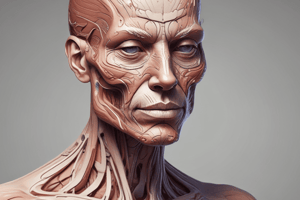Podcast
Questions and Answers
What percentage of the body weight does the skin account for?
What percentage of the body weight does the skin account for?
- 20%
- 25%
- 10%
- 16% (correct)
What is the main type of epithelium found in the epidermis?
What is the main type of epithelium found in the epidermis?
- Simple squamous epithelium
- Stratified columnar epithelium
- Cuboidal epithelium
- Stratified squamous keratinized epithelium (correct)
What is the function of melanocytes in the epidermis?
What is the function of melanocytes in the epidermis?
- To produce melanin for protection against ultraviolet light (correct)
- To regulate body temperature
- To produce keratin filaments
- To absorb ultraviolet light
What is the layer of the epidermis responsible for continuous renewal of epidermal cells?
What is the layer of the epidermis responsible for continuous renewal of epidermal cells?
What are the bundles of keratin filaments in Stratum spinosum called?
What are the bundles of keratin filaments in Stratum spinosum called?
What is the thickness of the epidermal layer for thick skin?
What is the thickness of the epidermal layer for thick skin?
What is the main function of the keratohyaline granules in the stratum granulosum?
What is the main function of the keratohyaline granules in the stratum granulosum?
What is the primary function of melanocytes in the skin?
What is the primary function of melanocytes in the skin?
What type of cells are Langerhans cells derived from?
What type of cells are Langerhans cells derived from?
What is the primary function of Merkel's cells in the skin?
What is the primary function of Merkel's cells in the skin?
What is the main characteristic of the stratum lucidum?
What is the main characteristic of the stratum lucidum?
What is the main function of the desmosomes in the epidermis?
What is the main function of the desmosomes in the epidermis?
Flashcards are hidden until you start studying
Study Notes
Skin Composition and Functions
- The skin is the heaviest single organ of the body, accounting for about 16% of the body weight and covering an area of 1.2-2.3 m2 in adults.
Skin Layers
- The skin consists of three main layers: epidermis, dermis, and hypodermis (subcutaneous tissue).
Functions of the Skin
- Prevents water loss
- Acts as a receptor organ with the external environment
- Protects against friction
- Protects from ultraviolet light through melanin production
- Regulates body temperature (thermoregulation)
- Metabolizes various substances
- Excretes waste products
Epidermis
- Consists mainly of stratified squamous keratinized epithelium
- Contains three other cell types: melanocytes, Langerhan's cells, and Merkel's cells
- Thickness varies between 75-150 μm for thin skin and 400-600 μm for thick skin
Epidermal Layers
- Stratum basale (Stratum germinativum): a single layer of basophilic columnar or cuboidal cells responsible for continuous renewal of epidermal cells
- Stratum spinosum: consists of cuboidal or slightly flattened cells with keratin filaments and desmosomes
- Stratum granulosum: consists of 3-5 layers of flattened polygonal cells with keratohyaline granules
- Stratum lucidum: a translucent thin layer of extremely flattened eosinophilic epidermal cells
- Stratum corneum: consisting of 15-20 layers of flattened non-nucleated keratinized cells
Melanocytes
- Responsible for skin color due to melanin and carotene
- Found beneath and between cells of stratum basale and in hair follicles
- Have rounded cell bodies with numerous cell extensions
- Not attached to surrounding cells by desmosomes, but by hemidesmosomes to the basal laminae
Langerhan's Cells
- Star-shaped cells found mainly in the stratum spinosum
- Represent 2-8% of epidermal cells
- Bone marrow derived
Merkel's Cells
- Present in the thick skin of palms and soles
- Resemble epidermal epithelial cells but have small dense granules in their cytoplasm
- Free nerve endings are present at the base of Merkel's cells
- May serve as sensory mechanoreceptors
Dermis
- A connective tissue that supports the epidermis
- Thickness varies from region to region
- Surface has many projections (dermal papillae) interdigitating with projections (epidermal pegs or ridges) of the epidermis
- Consists of two layers: papillary and reticular layers
Studying That Suits You
Use AI to generate personalized quizzes and flashcards to suit your learning preferences.




